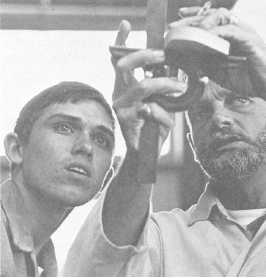perspective they do not always see (fig. 12-7). All of the
qualities mentioned are a must for a news photographer
striving for good photographic composition.
Essentially,
photographic
composition
is
a
harmonious combination of a main subject and its
supporting elements. This means you must be able to
recognize these elements and then arrange them into the
photograph that will tell your story.
Learning the art of good composition is similar to
mastering any other skill. First you must understand the
rudiments. Then, through much practice and attention,
you develop your talent to the highest degree of
perfection possible.
In the early stages of learning, we depend almost
exclusively on what we can see and hear, imitating what
has been done before. Much can be learned about
composition by studying various works of art and
collections of good photographs. Each one offers an
example of how to present a subject in an effective and
interesting manner. By attempting to duplicate some of
these photographs, you can acquire an understanding of
the basic elements of composition.
The proper placement of the subject within the
space of the photograph is one of the most important
elements of good composition. Whenever possible, you
should select and arrange the subject elements, choosing
the viewpoint and lighting conditions that present the
subject best. You also should arrange the subject in the
photograph in such a way as to clearly and pre-
dominantly be the main point of interest. The main idea
of the photograph should be recognizable immediately to
anyone viewing your photograph.
In aiming for good composition, you should learn
and use the following principles as guides: l Simplicity
Point of interest
Compositional lines
Balance
Forms
Rhythm or pattern
Tone
Depth perception
Action
Security and safety considerations
Your awareness, application and practice of these
principles when composing a scene will assist you
greatly in making an interesting presentation of your
subject.
SIMPLICITY
Frequently, the simplest arrangement of your
subject matter makes the most interesting presentation.
Although each photograph consists of numerous small
parts and contributing elements, none of these should
appear conspicuous or portray more interest than the
main object. The main object is the reason for making
the photograph in the first place; all other elements
should merely support and emphasize it. The scene
should not be cluttered with a confusing number of
objects and lines that detract from the subject. You
should select a viewpoint that eliminates surrounding
distractions so the principal subject is readily
recognized. If numerous lines or shapes are competing
for interest with the subject, it may be difficult to
recognize the main object or determine why the
photograph was made.
Study the scene from all angles and decide exactly
what you want to show; then strive to maintain this
single idea as clearly as possible by eliminating
unimportant
or
distracting
elements
from
the
photograph. Keeping the arrangement simple makes the
job of composition easier and the photograph more
interesting.
POINT OF INTEREST
With few exceptions, most photographs should
have a single point of interest that tells the viewer this is
the reason for taking the photograph. All other details
support the point of interest. The point of interest is the
point to which the eyes are drawn (fig. 12-8). If there is
Figure 12-8.—The eyes of the viewer are drawn to the
point of interest.
12-11


